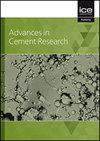Hydration of a 2-component CSA-OPC-mix – timing of component blending & setting on demand
IF 1.4
4区 工程技术
Q3 CONSTRUCTION & BUILDING TECHNOLOGY
引用次数: 0
Abstract
With the ongoing development of new technologies like 3D printing, the requirements for the performance of cementitious materials become more complex. Setting on demand, while the workability of the material is retained until placement, is an important aspect of this usage. A ternary CSA-OPC-C$ system was developed to achieve setting on demand in a 2-component setup, where two retarded cementitious components were mixed after specific times of storage. The kinetics of the individual systems and the blend were examined by heat flow calorimetry, quantitative X-ray diffraction and pore water analysis. The rheological development was monitored by a penetration test method. The results show that the performance of the blend is independent of the storage time of the individual components and can be tailored by changes in the retarder dosage in the individual components. The initial reaction in the blend is characterized by the simultaneous dissolution of ye'elimite and C3S, resulting in the formation of ettringite as the sole detectable hydrate phase. The fate of silicon remains unclear as with the methodology at hand no silicon incorporating hydrate phase can be identified.双组分 CSA-OPC 混合物的水合--组分混合时间和按需设定
随着 3D 打印等新技术的不断发展,对水泥基材料性能的要求也变得更加复杂。按需凝结,同时在浇注前保持材料的可加工性,是这种用途的一个重要方面。我们开发了一种三元 CSA-OPC-C$ 系统,用于在双组分设置中实现按需凝结,其中两种缓凝胶凝组分在特定储存时间后混合。通过热流量热仪、定量 X 射线衍射和孔隙水分析对单个体系和混合体系的动力学进行了研究。流变发展情况则通过渗透试验法进行监测。结果表明,混合物的性能与单个成分的储存时间无关,并且可以通过改变单个成分中缓凝剂的用量来调整。混合物的初始反应特点是叶焰硝和 C3S 同时溶解,形成乙丁睛石作为唯一可检测到的水合物相。硅的去向仍不清楚,因为根据现有的方法,无法确定含有硅的水合物相。
本文章由计算机程序翻译,如有差异,请以英文原文为准。
求助全文
约1分钟内获得全文
求助全文
来源期刊

Advances in Cement Research
工程技术-材料科学:综合
CiteScore
3.70
自引率
5.00%
发文量
56
审稿时长
3.2 months
期刊介绍:
Advances in Cement Research highlights the scientific ideas and innovations within the cutting-edge cement manufacture industry. It is a global journal with a scope encompassing cement manufacture and materials, properties and durability of cementitious materials and systems, hydration, interaction of cement with other materials, analysis and testing, special cements and applications.
 求助内容:
求助内容: 应助结果提醒方式:
应助结果提醒方式:


